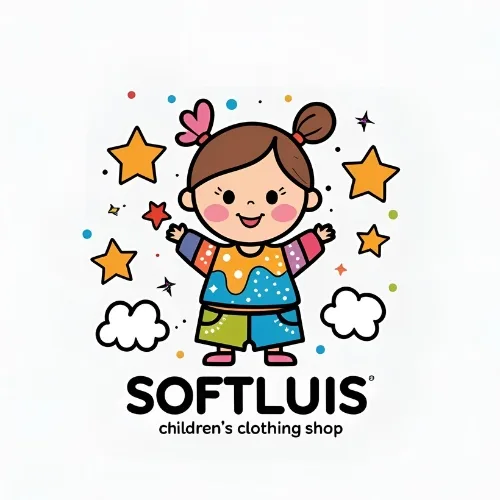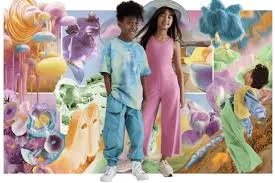News
Fashion Trends for Kids in 2025
Fashion Trends for Kids in 2025: A Complete Guide for Parents
Introduction
Fashion is never just about clothes. It’s about how we feel, how we express ourselves, and how we show the world who we are. For kids, fashion is even more meaningful. It’s not just cute outfits for Instagram photos—it’s comfort, it’s identity, and it’s confidence during their early years. Parents everywhere want their little ones to feel good in what they wear, whether it’s the first day of school, a family outing, or just a cozy afternoon at home.
As we step into 2025, children’s fashion is going through exciting changes. It’s not about dressing kids like mini-adults anymore. It’s about finding balance between style, safety, sustainability, and individuality. Parents are demanding fabrics that are gentle on sensitive skin, designs that are practical for play, and looks that reflect personality. Brands are listening—and the trends this year are all about that mix of comfort, function, and flair.
This guide will take you through the biggest kids’ fashion trends in 2025, why they matter, and how you can make the best choices for your child.
1. The Rise of Sustainable Kids’ Fashion
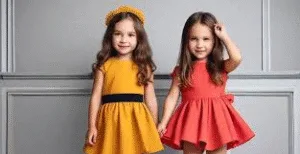
In the past, parents used to buy clothes for kids based mainly on price or cuteness. But 2025 is different. More families are aware of how clothing impacts both their child’s health and the planet. Sustainable kids’ fashion is no longer a niche—it’s mainstream.
Organic Cotton and Bamboo Fabrics
Parents are moving away from synthetic fabrics like polyester that trap heat and irritate sensitive skin. Instead, organic cotton and bamboo have become favorites. These fabrics are breathable, hypoallergenic, and super soft. Bamboo in particular has natural moisture-wicking properties, which makes it great for active toddlers.
For example, parents might choose a bamboo pajama set for summer nights to keep their little one cool, or an organic cotton hoodie for playground time. These materials wash well, last longer, and don’t lose shape as quickly. That’s important when kids outgrow clothes so fast—you want durability for hand-me-downs or resale.
Eco-Friendly Dyes and Production
Another big shift is the use of plant-based or low-chemical dyes. Nobody wants toxins touching a baby’s skin. Clothes made with safe dyeing processes are not only better for kids but also for the environment. Many brands are advertising this on their tags now—so parents know exactly what touches their child’s skin.
2. Gender-Neutral Designs
The days of only pink for girls and blue for boys are fading. Parents in 2025 are embracing gender-neutral fashion for their kids. This doesn’t mean all clothes are gray or bland. It means giving kids freedom to choose bright yellows, fun greens, calming neutrals, or funky patterns—without labeling them as “for boys” or “for girls.”
Practical Benefits
Gender-neutral clothes are easier to pass down between siblings. A yellow raincoat or a green hoodie can be worn by any child, regardless of gender. This makes shopping smarter and more sustainable.
Stylish and Fun
Brands are also making gender-neutral collections stylish and playful—think bold animal prints, space themes, or nature-inspired designs. Parents love this because kids get to express personality without stereotypes.
3. Miniature Streetwear
Streetwear isn’t just for adults anymore—it has trickled down into kids’ fashion in a big way. In 2025, you’ll see mini jogger pants, oversized hoodies, baseball caps, and even tiny sneakers that look like the coolest adult brands.
Comfort Meets Cool
What makes streetwear popular for kids is that it’s both trendy and comfortable. Joggers with elastic waists, hoodies made from soft fleece, and sneakers with breathable mesh all let kids move easily while looking stylish.
Parent-Child Twinning
Another fun trend: “mini-me” outfits where kids dress like their parents. Matching hoodies or sneakers have become a family fashion statement. It’s not about forcing style but creating bonding moments. Imagine a dad and son both in relaxed-fit hoodies or a mom and daughter with matching denim jackets—it’s adorable and fashionable.
4. Tech-Infused Kids’ Clothing
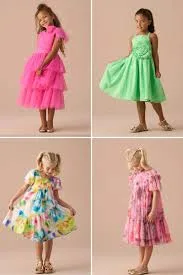
2025 has brought technology into kids’ closets. Don’t worry—it’s not as futuristic or intimidating as it sounds. It’s practical, and parents are excited about it.
Smart Fabrics
Some kids’ clothes now use smart fabrics that regulate temperature. For example, a jacket that keeps a child warm outside but doesn’t cause overheating indoors. Other fabrics are stain-resistant, which is a lifesaver for parents dealing with messy meals or outdoor play.
Safety Features
Glow-in-the-dark stripes on jackets, GPS-tracked smartwatches for kids, and even shoes with reflective materials are growing in popularity. Parents love these innovations for safety during evening walks or school commutes.
5. Seasonal Color Palettes for Kids in 2025
Color is one of the most fun parts of fashion. In 2025, kids’ fashion colors are cheerful but grounded. Here are the key shades dominating wardrobes:
Soft Earthy Tones: Clay, sand, sage green—these calming shades reflect the eco-conscious vibe of parents.
Playful Brights: Sunshine yellow, coral pink, and teal for lively kids with big personalities.
Classic Neutrals: White, beige, and gray remain staples for layering and minimalist looks.
Pastel Mixes: Lavender, mint, and baby blue—still favorites for spring and summer wardrobes.
6. Functional and Practical Fashion
Parents today value practicality as much as cuteness. Fashion for kids must handle messy playdates, spilled juice, and rough playground adventures.
Easy-to-Wash Fabrics
Busy parents don’t have time for dry cleaning. Clothes that can handle frequent washes and still look new are in high demand.
Adjustable Designs
Clothes with elastic waists, adjustable straps, or extendable sleeves are trending because they grow with the child. Instead of buying new pants every six months, parents get extra wear from adjustable fits.
Layering Options
Cardigans, zip-up hoodies, and lightweight jackets make layering easy for unpredictable weather. This flexibility is something parents really appreciate in 2025.
7. Special Occasion Kids’ Fashion
Even though comfort dominates, parents still want their children to look special for birthdays, weddings, or holidays. 2025 trends here include:
Mini Formalwear: Linen suits for boys, tulle dresses for girls—but designed with comfort in mind (soft linings, stretchy waistbands).
Mix of Casual and Fancy: Pairing sneakers with dresses or joggers with blazers for a playful yet classy look.
Cultural Inspirations: Many parents want clothes that celebrate heritage—whether it’s embroidered patterns, traditional fabrics, or fusion designs.
8. Accessories and Details
Clothes are only part of the outfit. Accessories for kids are also trending in 2025.
Hats and Caps: From wide-brimmed sun hats to cool snapbacks.
Backpacks and Mini Bags: Functional but with fun prints like dinosaurs, galaxies, or animals.
Hair Accessories: Colorful clips, bows, and headbands are making a comeback.
Statement Shoes: Sneakers with cartoon themes or sandals in bright colors let kids show off individuality.
9. Local and Handmade Brands
More parents in 2025 are supporting local designers and handmade shops. These brands often focus on high-quality fabrics and unique designs, avoiding the “fast fashion” trap. Parents also like knowing exactly where their child’s clothes come from.
For example, a handmade organic cotton romper from a local shop feels more personal and special than a mass-produced item. This trend also supports small businesses and aligns with the sustainability movement.
10. The Future of Kids’ Fashion Beyond 2025
Where is kids’ fashion heading next? Based on 2025 trends, the future looks exciting:
More tech integration: Fabrics that monitor temperature, hydration, or even sun exposure.
Greater inclusivity: Designs for children with disabilities—adaptive clothing that is stylish and functional.
Circular fashion: Brands creating buy-back or resale programs so clothes can have a second life after kids outgrow them.
Fashion by Age Group: From Babies to Tweens
When talking about children’s fashion, it’s easy to think of it as one category. But the truth is, fashion needs are very different depending on age. A baby has different needs from a five-year-old who loves running at the playground, and that same five-year-old has different needs once they turn ten and start noticing what their friends are wearing.
Babies (0–12 months)
For infants, comfort and safety come first. Parents look for soft fabrics like organic cotton or bamboo that won’t irritate delicate skin. One-piece rompers, sleep sacks, and onesies dominate this stage. The trend in 2025 is minimalist but adorable—neutral colors, soft pastels, and subtle prints like clouds, stars, or little animals. Buttons and zippers are being replaced by safer snaps and magnetic closures to make late-night diaper changes easier for parents.
Toddlers (1–3 years)
This is the age of curiosity and constant motion. Toddlers climb, crawl, fall, and get messy in seconds. Fashion trends here focus on durability and playfulness. Elastic waists, stretchy fabrics, and reinforced knees are becoming popular. Bright, bold colors and patterns reflect the energy of this age. Think rainbow stripes, cartoon prints, and playful slogans. Parents are also buying mix-and-match sets—tops and bottoms that can pair in multiple ways—to simplify dressing.
Preschool and Early School Years (4–7 years)
At this stage, kids start to express opinions about what they wear. They might insist on their favorite superhero shirt or a dress that twirls. Fashion trends embrace individuality—brands offer character-themed items, but also stylish basics that can be personalized. Sneakers are essential, often in fun colors or with LED lights. For girls, tutus layered over leggings are still a hit. For boys, sporty joggers and hoodies dominate. Gender-neutral collections also shine here, with nature themes, dinosaurs, or outer-space designs.
Tweens (8–12 years)
This is where kids lean closer to adult fashion, but with a playful twist. Streetwear, denim jackets, layered looks, and branded sneakers are trending. Many tweens want to copy older siblings or celebrities they admire. Influencers on YouTube or TikTok often inspire these fashion choices. Parents balance allowing self-expression while ensuring outfits are age-appropriate. Sustainable fashion is becoming popular among tweens as they are more aware of social issues—many actually ask their parents for eco-friendly brands.
Global Inspirations in Kids’ Fashion
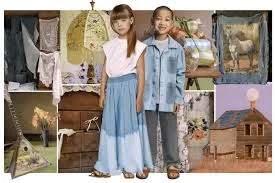
Kids’ fashion in 2025 isn’t just influenced locally. Thanks to social media and global trade, parents and children are inspired by styles from all over the world.
Japan: Known for “kawaii” culture, Japanese kids’ fashion includes oversized sweaters, pastel palettes, and quirky accessories. It’s cute, fun, and expressive.
Europe: Countries like France and Italy favor timeless, classic looks. Think linen shirts, berets, simple dresses with clean lines. Less flashy but elegant.
United States: Streetwear and sportswear dominate, with brands like Nike, Adidas, and Converse leading the way for kids. Casual but trendy.
Latin America: Bright colors, floral patterns, and cultural embroidery influence kids’ fashion, reflecting joy and tradition.
Africa: Vibrant prints and bold fabrics inspire collections worldwide. Ankara-inspired designs for kids are appearing in mainstream stores.
This global exchange makes kids’ wardrobes in 2025 more diverse than ever. A child in New York might wear a Japanese-inspired hoodie, a European-cut jacket, and sneakers from a Latin American brand—all in the same outfit.
The Influence of Celebrities and Media
Whether parents like it or not, kids are heavily influenced by what they see on TV, YouTube, or TikTok. In 2025, many kids want to dress like their favorite child stars, influencers, or even cartoon characters.
When a celebrity child appears in a unique outfit, it can set off a mini trend. For example, when the daughter of a famous singer wore a neon tracksuit, many kids asked their parents for something similar. Social media platforms amplify this—photos go viral, and kids notice.
Brands now collaborate with influencers and child celebrities to launch limited-edition collections. These sell out fast, creating buzz among parents and kids alike. Some parents embrace it as a fun way for kids to feel connected, while others worry about commercial pressure. Either way, media plays a huge role in shaping what children ask to wear.
The Balance Between Budget and Trends
One challenge parents face is balancing fashion trends with budget. Children outgrow clothes so quickly that buying expensive trendy pieces can feel wasteful.
That’s why 2025 has seen the rise of affordable sustainable brands and resale platforms for kids’ clothing. Parents can now buy pre-loved trendy outfits in excellent condition, or trade clothes their kids have outgrown. Some brands even offer subscription services: you pay monthly, get a box of trendy outfits, and swap them when your child outgrows them.
This approach saves money, reduces waste, and keeps kids stylish. Parents don’t feel pressured to overspend, while kids still get to enjoy the latest looks.
Seasonal Kids’ Fashion in 2025
Let’s break down what kids are wearing by season:
Spring: Light jackets, pastel dresses, floral prints, sneakers. Lots of layering for unpredictable weather.
Summer: Breathable cotton shorts, bamboo tees, sun hats, and sandals. Swimwear with UV protection is trending.
Autumn: Earthy tones, cozy sweaters, plaid patterns, boots. Streetwear-inspired hoodies dominate.
Winter: Puffer jackets, woolen beanies, waterproof boots. Smart fabrics that keep kids warm without bulk are a huge hit.
FAQs for Parents
Q: Is polyester really bad for kids?
Not always. While natural fabrics are preferred, some blends with polyester make clothes more durable and easier to wash. The key is balance—choose blends with high cotton content.
Q: How many outfits does a child really need?
It depends on age. Babies may need 10–12 onesies because of frequent changes, but school kids can manage with a weekly rotation of 7–10 outfits.
Q: Are trends worth following for kids who grow fast?
Yes, but smartly. Invest in a few trendy pieces for special occasions and keep the rest of the wardrobe practical and sustainable.
Q: What’s the best way to shop sustainably?
Look for organic fabrics, shop secondhand, and support local brands. Also, choose adjustable clothes that grow with your child.
Looking Ahead: The Future Beyond 2025
The kids’ fashion industry is still evolving. Here’s what we might see in the next few years:
Adaptive Clothing: More stylish options for children with disabilities, using magnetic closures, soft seams, and easy-access designs.
Circular Fashion: Companies offering “buy back” programs where used clothes are recycled or resold.
Smart Fabrics 2.0: Clothes that monitor body temperature, hydration, or UV exposure to protect kids outdoors.
Personalized Fashion: With AI and 3D printing, we may see on-demand custom outfits for kids in their favorite colors and patterns.
Kids’ Fashion and Emotional Development
Clothing plays a surprisingly important role in how children perceive themselves and how they are perceived by others. For a child, wearing a favorite T-shirt with their beloved cartoon character or a dress in their favorite color can make a real difference in their confidence and mood. Studies in developmental psychology show that self-expression through clothing helps children build identity and autonomy. For example, a child who insists on wearing bright, mismatched socks may be exercising independence and creativity rather than defiance. Fashion in this sense becomes a language of emotions—joy, comfort, shyness, or boldness—communicated without words.
Parents increasingly recognize that outfits are not merely functional but also deeply tied to emotional well-being. A child who feels comfortable in their clothing tends to participate more actively in school, social play, and even sports. On the other hand, restrictive, itchy, or poorly fitted clothes can make them distracted, irritable, and less confident. Therefore, investing in soft fabrics, adjustable fits, and styles that reflect the child’s personality contributes positively to their emotional development.
Back-to-School Fashion Trends
Every academic year brings with it a wave of back-to-school fashion. While uniforms are still required in many schools around the world, accessories and casual wear outside of school hours give children the chance to express their style. Sneakers remain one of the most important categories, with kids often identifying with brands that mirror what older siblings or influencers wear. Backpacks have also become a fashion statement, ranging from minimalist eco-friendly designs to playful versions featuring gaming or superhero themes.
For younger students, parents often choose durable clothing such as reinforced denim, cotton polos, or dresses with hidden pockets for convenience. For older children, individuality becomes more important. Middle schoolers and high schoolers may gravitate toward layered looks, oversized hoodies, and branded caps. This shift highlights how children slowly adapt their wardrobe to resemble teenage and adult styles, bridging the gap between childhood and adolescence.
Back-to-school shopping is also heavily influenced by online marketing campaigns. Brands often release collections just before the school year starts, complete with bundles that include shoes, backpacks, and jackets. These curated sets make shopping more convenient for parents while maintaining a sense of trendy appeal for kids.
The Role of Parents in Kids’ Fashion Choices
Parents play a crucial role in balancing their child’s desire for independence with practical considerations like price, durability, and cultural appropriateness. Younger children typically rely on their parents to make most of the decisions, but as they grow older, they begin to assert preferences strongly. Some parents use clothing choices as a way to teach lessons in budgeting, sustainability, and even social awareness.
For example, a parent might allow their child to pick one “fun” or trendy item but pair it with more neutral, versatile pieces. This way, the child experiences freedom of choice while still learning about balance and practicality. In multicultural families, parents often integrate traditional garments with modern ones, teaching children pride in their cultural heritage while still fitting into mainstream fashion.
It is also important to note that disagreements over clothing are common between parents and children. These moments, however, can be opportunities for communication rather than conflict. By listening to the child’s reasoning—whether it is about comfort, aesthetics, or peer influence—parents can guide decision-making without undermining the child’s autonomy.
Special Occasions and Themed Fashion
Children’s fashion is particularly dynamic around holidays and celebrations. For example, Halloween has grown into a global phenomenon, with costumes ranging from classic witches and superheroes to unique DIY outfits. Christmas fashion, on the other hand, often features cozy knit sweaters, festive pajamas, and coordinated family outfits for photographs.
In cultures across Asia, Lunar New Year brings vibrant, traditional clothing, often in red and gold. Parents use these moments not only to celebrate but also to teach children about cultural values and traditions. Birthday parties, school performances, and weddings also drive demand for semi-formal outfits, such as dresses, vests, and smart shoes tailored for kids.
The themed fashion industry has grown so significantly that many brands now release limited seasonal collections. Parents often view these purchases as investments in family memories captured through photographs and social gatherings. The emotional attachment to these clothes often outlasts their actual usage.
Online Shopping and Social Media Influence
One of the biggest transformations in kids’ fashion has been the rise of online shopping. Parents now have access to thousands of options at their fingertips, from local handmade clothing to global designer brands. Online marketplaces allow easy comparison of prices, fabrics, and reviews, making decision-making far more efficient. Subscription boxes have also emerged, delivering curated outfits monthly or seasonally based on the child’s size, preferences, and upcoming events.
Social media, especially platforms like TikTok and Instagram, has amplified kids’ fashion trends. Influencers—sometimes even child influencers—showcase outfits, driving massive spikes in demand for particular styles. While this creates excitement and variety, it also puts pressure on parents to keep up with constantly changing micro-trends.
Fortunately, some communities use social media to promote sustainability, encouraging clothing swaps, upcycling, and second-hand shopping. These groups help balance the pressure of consumerism with more eco-friendly practices. Children who grow up seeing these conversations online may also adopt more conscious attitudes toward fashion consumption in the future.
The Future of Kids’ Fashion: Blending Function and Expression
Looking ahead, the kids’ fashion industry will continue evolving at the intersection of practicality, sustainability, and creativity. Smart clothing with built-in safety features—such as GPS trackers or temperature-regulating fabrics—may become mainstream. At the same time, digital fashion and virtual wardrobes may allow children to express themselves online without physical limitations.
The essence of kids’ fashion, however, will always revolve around three central values: comfort, identity, and joy. Whether it is a toddler twirling in a princess dress, a teenager showing off custom sneakers, or a parent choosing eco-friendly fabrics, clothing remains a deeply human way of connecting to self-expression and belonging.
